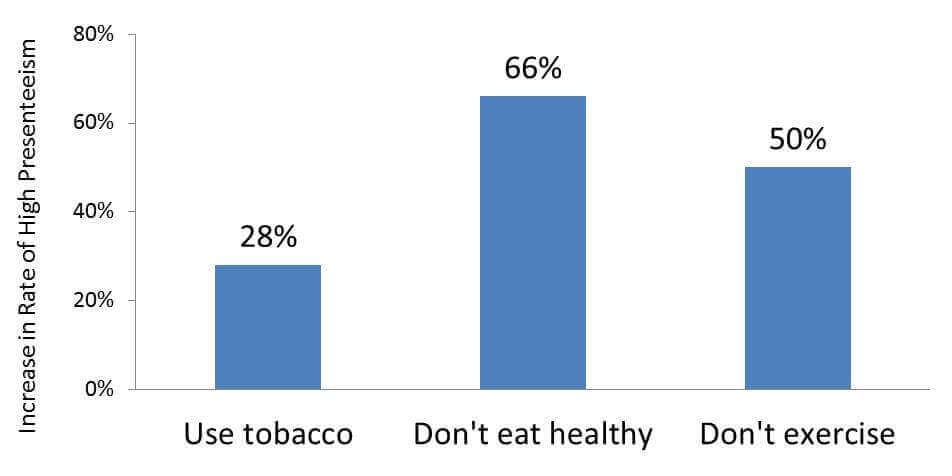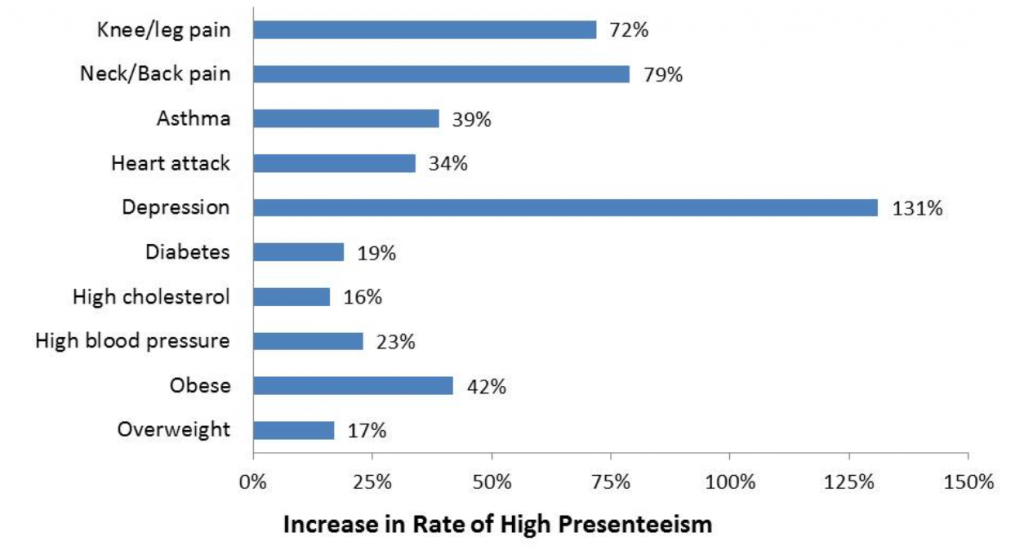Low employee output can often be attributed to staff members being physically present at their job but not engaging in work, a phenomenon known as presenteeism. The financial toll of presenteeism, primarily due to poor employee health, is believed to be two to three times the amount of direct health care expenses. Fortunately, workplace wellness programs can increase productivity by being an effective tool for enhancing employee health.
Despite the costs of presenteeism surpassing those associated with health care, this issue tends to be overlooked by employers who are more focused on the immediate costs related to employee health issues.
The reason presenteeism is less visible on the business radar is because it isn’t a quantifiable cost reflected in the financial books or reports. Employers are acutely aware of the monthly health care bills for their staff, feeling the immediate impact on their finances.

Checks are written, accounts debited, and these expenditures are carefully monitored and controlled. In contrast, no direct payments are made towards mitigating presenteeism. It’s rare for businesses to regularly monitor work performance in a manner that identifies the impact of presenteeism.
Although workplace wellness initiatives are praised for their potential to decrease presenteeism, there has been a lack of supportive data up until recent times.
Employers that manage to lower presenteeism rates can see significant improvements in workforce efficiency. Understanding the reduction of presenteeism through workplace wellness programs begins with a clear comprehension of its root causes.
Recent studies, such as those published in the Population Health Management journal, have shed light on the underlying factors of presenteeism, offering new insights into its causes.
1. New Research Helps Explain How Wellness Programs Increase Employee Productivity
In 2008, Healthways, a well-being improvement company, and Gallup formed a partnership. Their partnership formed to monitor well-being among communities throughout the United States by conducting 1,000 daily interviews with a survey called the Gallup-Healthways Well-Being Index (WBI).
A survey called the Well-Being Assessment was developed. It was created by Healthways to capture a comprehensive picture of well-being at the individual level. This tool, adapted from the community WBI survey, also measures employee presenteeism, health and well-being within an organization.
The Well-Being Assessment has been completed by numerous employers. In the new study cited above, data from three of these companies were used. These companies employed about 20,000 employees in diverse industries including insurance, health care, and a customer service call center.
Employees were made aware of and asked to complete the survey as a part of their benefits enrollment process. Employees were asked a series of questions about health behaviors such as smoking status, dietary habits, and physical activity.

Information was also collected on health risks such as body mass index (BMI), high blood pressure, high cholesterol, diabetes, depression, heart attack, asthma, cancer, chronic neck and back conditions that cause pain or knee or leg conditions that cause pain.
To measure presenteeism, employees were asked a series of questions around specific productivity barriers within their workplace. Employee responses to these questions were tallied and used to create a total presenteeism score.
2. Elevated Health Risks and Poor Behaviors Are Predictors of Poor Productivity
Presenteeism scores among these employees varied widely. So, to help detect patterns, employees with a presenteeism score in the top 20 percent were considered to have high presenteeism.
Multiple comparisons were made to understand how employee health behavior was associated with high presenteeism. These comparisons help clarify the relationship between employee health and presenteeism. And they show how participating in a wellness program can increase productivity at work.
For example, smokers were 28% more likely to have high presenteeism than non-smokers. Figure 1 shows the increased likelihood of high presenteeism among employees with three health behaviors. In addition to higher presenteeism among smokers, employees with an unhealthy diet were 66% more likely to have high presenteeism than those who regularly ate whole grains, fruits, and vegetables.
Employees who didn’t exercise very much were 50% more likely to have high presenteeism than employees who were regular exercisers. These findings demonstrate that poor health behaviors are strongly associated with high levels of presenteeism.
The Impact of Unhealthy Behaviors
In short, unhealthy individual lifestyle choices may result in substantially higher levels of lost productive work time.

This figure displays increased rates of high presenteeism among employees who smoke, don’t eat healthy, or don’t exercise regularly. Poor health behaviors eventually lead to elevated health risks and chronic diseases. The figure below shows how health risks such as excess body weight, elevated blood pressure, and high cholesterol increased the odds of having high presenteeism.
The other health conditions in this figure further paint the presenteeism picture – the presence of risk factors, pain and chronic disease, especially chronic depression, dramatically increase the odds of having high presenteeism.

These published results confirm several ideas that have previously been assumed but not directly tested. Presenteeism is associated with poor health behaviors as well as elevated health risks and the presence of chronic disease. This information is important because the number of employees with excess body fat, poor diets, and sedentary lifestyles has never been greater.

The rate of diabetes in the U.S. workforce has also risen to unprecedented levels. The increases in this and other lifestyle-related chronic diseases suggest that the cost associated with presenteeism and poor employee health is likely to grow in the absence of effective strategies to reverse these trends. One strategy is to implement an employee wellness program to help employees be healthier and thus increase productivity.
3. Leaders Are Seeing the Evidence
Employees who fail to receive a flu shot may get lucky and not get the flu. But those who do get the flu may miss some days of work or, alternatively, will be less productive at work and spread this illness to co-workers.
Getting a flu shot can prevent the flu and associated lost productive time. A flu shot is relatively easy to get, inexpensive, and can prevent presenteeism.
This is just one example of how a worksite can implement an employee health management strategy that maintains employee health and improves productivity. Employee health management or wellness programs can have a direct impact on presenteeism. They are the best practical solution to curb the hidden costs of presenteeism and increase productivity.
There is ample evidence that properly implemented worksite wellness programs can improve employee health and productivity. The evidence that these programs can also reduce employee presenteeism is growing.
Despite this substantial and growing body of evidence, many employers are still reluctant to fully implement wellness strategies. Here are the top 5 workplace wellness statistics every employer should know.
In some cases, management remains skeptical that there will be a tangible improvement in health if they make this investment.
What About Small Companies?
This skepticism is a particular concern among leaders of small and mid-sized companies, who may question whether effective wellness strategies reported by larger employers are practical for them.
Fortunately, HERO and others began to demonstrate that small companies can create leadership-driven wellness efforts that improve employee health and productivity.
Leadership reluctance is also based on the fact that, “companies don’t write checks for presenteeism.” Presenteeism is a hidden cost that contributes to financial reports as increased revenue or profitability only when it is prevented. Even then, the dollar value of this prevention is invisible.
Key to this issue is the fact that standardized, well-accepted tools for measuring presenteeism and workforce productivity have not yet achieved broad adoption in businesses. The adage that “you cannot manage what you don’t measure” is an unfortunate reality when it comes to presenteeism.
Are Wellness Programs Successful?
Worksite wellness programs have historically focused on reducing heath care costs. This research highlights that the benefits of healthy employees extend beyond reducing health care cost trends to improving employee wellness and reducing the impact of employee health on productivity. Presenteeism is here to stay, and it will only get worse if current trends continue.
The one viable way to improve employee health and lower presenteeism is to implement an effective worksite wellness program that engages employees and supports them in improving their health.
Does Wellbeing Increase Productivity?
Employees who maintain healthy lifestyles tend to perform better and manage their stress and time more efficiently. They are more likely to have better energy levels and are less likely to get sick. Explore more about how healthy employees contribute to a productive work place in this article.
How Can Wellness Programs Help Your Workforce? WellSteps Testimonials:
“I have been able to make better food choices. Making dinners that are healthier are not as hard as I once thought.”
“I was gaining weight in March 2020 and was worried that my family would get sick and die after getting my husband through a cancer treatment last year. I needed to get rid of this weight and make all of my health appointments and concentrate on my health on a daily basis instead of wasting my time worrying. On my birthday in June, I began to eat differently including eliminating gluten, walking and losing over 40 lbs.”
“I have really enjoyed the WellSteps program so far. I have always tried to live a healthy lifestyle but have never really been consistent with it since getting out of the Military. This program has really helped keep me on track to reach my goals!”
“I have lost 165 pounds in a year and a half… WellSteps has been a huge part of my success. I highly suggest all employees start using it!”
“Since starting WellSteps, we have been far more active in the office! Everyday a large group will use a part of their break and we walk about 2 miles in the business park. I have lost 12lbs in the last 3 months, and my coworkers are shedding pounds as well! Not only are we feeling good, our team morale has increased too! Can’t wait to see where this journey takes us!”
Looking for more? Check out 7 Important Reasons to Offer Employee Well-being at Work or schedule a demo today.

